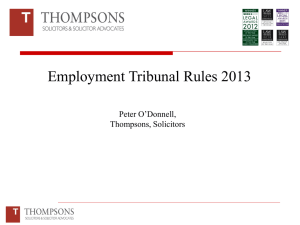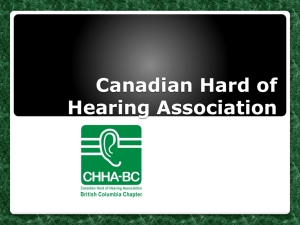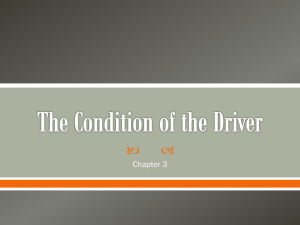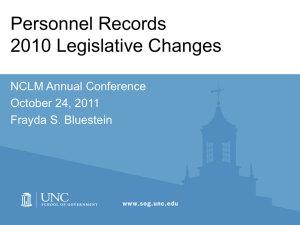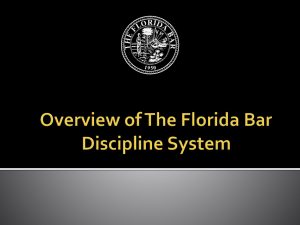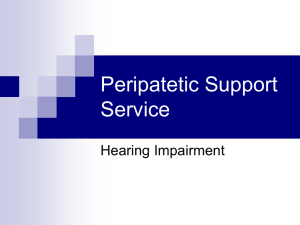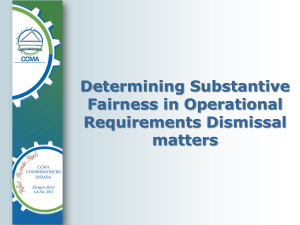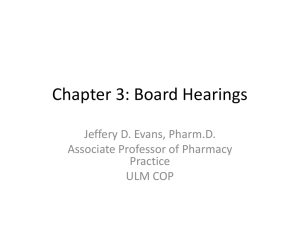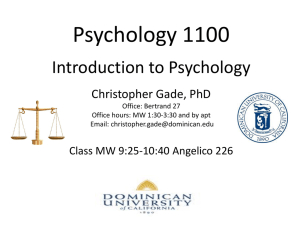Understanding Tenured Teacher Dismissals under P.A. 97-008
advertisement
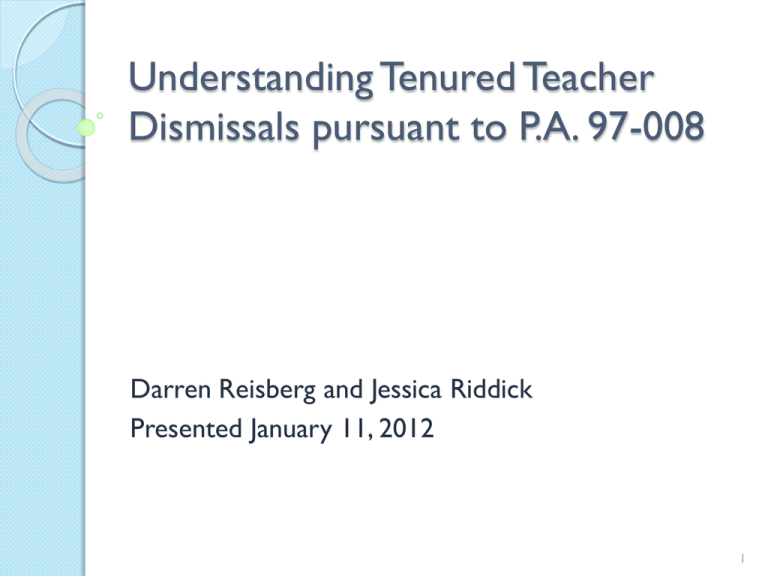
Understanding Tenured Teacher Dismissals pursuant to P.A. 97-008 Darren Reisberg and Jessica Riddick Presented January 11, 2012 1 Welcome! The PowerPoint presentation will be available later today at http://webapps.isbe.net/educatordismissals /Tenured_Teacher_Dismissals_011112.pp tx. 2 Purpose of the Webinar Update hearing officers, administrators, teachers and others on changes to the tenured teacher dismissal system in Illinois. 3 Recent Education Reform Legislation P.A. 96-861 (SB 315): The Performance Evaluation Reform Act (effective, January 15, 2010) ◦ Required that school districts, at specified points in time, incorporate data and indicators of student growth into teacher and principal performance evaluations ◦ Did not make any material changes to the tenured teacher dismissal process P.A. 97-008 (SB 7) (effective, June 13, 2011) ◦ Tied certain employment decisions, such as reductions in force, the acquisition of tenure and the filling of new and vacant positions, to performance ◦ Streamlined and made certain structural changes to the tenured teacher dismissal process, with the overarching goals of maintaining fairness for the tenured teacher and preserving district resources 4 Relevant Statutory and Regulatory Sections Section 24-12(d) of the Illinois School Code: Governs dismissal process for all districts other than CPS ◦ Performance- or evaluation-based dismissals (i.e., resulting from performance evaluations conducted pursuant to Article 24A of the School Code) ◦ Conduct-based dismissals Section 34-85 of the School Code: Governs dismissal process for CPS (both tenured teachers and principals) ◦ Performance- or evaluation-based dismissal ◦ Conduct-based dismissal Section 24-16.5 (new): Optional PERA dismissal process (discussed further in the presentation) Part 51 of Title 23 of the Illinois Administrative Code: Administrative rules establishing the procedures for tenured teacher dismissals (for which amendments will soon be proposed, as discussed further in the presentation) 5 Written Notice to Teacher & Motion by Board Before setting a hearing on charges stemming from causes considered “remediable,” a board must give the teacher reasonable warning in writing, stating specifically, the causes that, if not removed, may result in charges No written warning is required if the causes have been the subject of a remediation plan pursuant to Article 24A of the School Code (performance evaluations) 6 Notice of charges to the tenured teacher Downstate: Written notice, including bill of particulars Served on teacher within 5 days after board approval Include hearing officer selection options (after 7/1/12) (further discussed later in the presentation) CPS: Written notice of charges, including specifications Served on teacher within 10 business days after approval of the charges Include hearing officer selection options (after 7/1/12) (further discussed later in the presentation) 7 Request for hearing by teacher Teacher must request hearing in writing within 17 calendar days after receipt of notice Teacher must choose a hearing officer selection option (mutual selection or board selection) Parties share cost of mutually selected hearing officer; board pays for board-selected hearing officer Teacher may be suspended without pay pending hearing but if dismissal is not sustained, teacher shall not suffer the loss of any salary or benefits by reason of the suspension 8 Hearing Officer qualifications Clarification to required experience – 5 years experience in labor and management relations no longer limited to the education sector Beginning 9/1/12, must have completed ISBE Hearing Officer training so that the HO is familiar with issues generally involved in evaluative and non-evaluative dismissals (this is not the same pre-qualification/training as will be required of those evaluating principals and teachers under Section 24A-3 of the School Code) Available to commence hearing within 75 days of appointment and conclude within 120 days Not a resident of the district (though, in CPS, HOs may now reside within the district) Able to issue decision re: dismissal within 30 days from later of conclusion of hearing or closure of record 9 Downstate: Hearing Officer selection ISBE maintains master list of qualified HOs If notice of dismissal is sent prior to 7/1/12, OR if it is sent after 7/1/12 and the teacher opts for a mutually selected HO, ISBE provides list of 5 HOs 3-business day period for parties to alternately strike names or reject list ◦ ISBE selects any HO from master list who did not appear on the rejected list, unless the parties agree to select a HO not on the master list If teacher opts for board-selected HO, board will select any HO from the master list and notify ISBE within 3 business days 10 CPS: Hearing Officer selection CPS maintains list of at least 9 qualified HOs (developed in good faith consultation with exclusive teacher and principal representatives) 5 business day period to alternately strike names If the teacher or principal does not participate in striking process, general superintendent selects – either from CPS list or ISBE master list 11 Hearing Officer fees ISBE pays HO from state funds if notice of dismissal is sent to teacher prior to 7/1/12 If notice is sent on or after 7/1/12: ◦ Fees & costs determined by ISBE, but fees & costs no longer paid by the state ◦ Parties may agree to supplement fees of a mutually-selected HO not on ISBE’s list ◦ Parties share cost of mutually-selected HO (50% - 50%) ◦ Board pays 100% of board-selected HO 12 Prehearing & Discovery Teacher shall answer the bill of particulars (Downstate) or charges and specifications (CPS) and aver any affirmative defenses HO schedules pre-hearing conference to set discovery schedule and deadlines for initial disclosures (witnesses and exhibits) and updates thereto Interrogatories and Requests for Production allowed. Additional discovery by HO discretion; however discovery depositions are prohibited by statute All to be further fleshed out in forthcoming rulemaking 13 Hearing, Witnesses & Scope Subject to exception for good cause or by mutual agreement: ◦ Hearing must commence within 75 days and conclude within 120 days after selection of HO ◦ Each party shall have 3 days to present its case. ISBE is to further define “day” in its forthcoming rulemaking (e.g., 7.5 hours such that the limitation for each party is 22.5 hours) HO may limit each party to subpoena 7 witnesses S.Ct. Rule 241: testimony by video-conference allowed for good cause shown with adequate safeguards In Art. 24A dismissals, HO must consider all evaluations relevant to the issues at hearing 14 “Good cause” “Good cause” is defined as illness or other unavoidable emergency of the teacher, district representative, or their legal representatives, the HO or essential witness (as indicated in pre-hearing filing) 15 Court reporters and transcripts HO shall arrange for court reporter; court reporter’s fees shall be paid by the party (or parties) paying for the HO Parties pay for own copy of transcript 16 Post-hearing briefs May be filed up to 21 days after receipt of transcript (unless deadline is extended by HO for good cause or by mutual agreement of the parties). ISBE will develop rules to limit page length of briefs (e.g., not to exceed 20 pages, barring exception granted by HO for good cause). 17 HO Recommendation/ Decision Downstate: HO issues decision of retention or dismissal in Article 24A (performance evaluation) matters OR issues findings of fact and recommendation for dismissal for “conduct” (significant change from pre-SB7 structure) Within 30 days after close of record CPS: HO issues findings of fact and recommendation to the board Within 30 days after close of record 18 Board action No procedural changes for CPS Downstate: (in “conduct” dismissals) ◦ Within 45 days after receipt of HO findings of fact & recommendation as to (i) whether the conduct at issue occurred; (ii) the conduct that did occur was remediable; and (iii) the proposed dismissal should be sustained, board must issue a written order to either retain or dismiss ◦ School board may modify or supplement findings of fact if board believes those findings are against the manifest weight of the evidence ◦ If HO recommends retention and board dismisses, board must state in its written order the reasons for its decision 19 Administrative Review CPS: Administrative Review Law Action initiated in IL App Ct (1st Dist). If appellate court orders reinstatement, will remand to board for back pay, etc. Board prepares and files Record; parties share cost Downstate: Administrative Review Law Board prepares and files Record; parties share cost If trial court orders reinstatement, will remand to board for back pay, etc. Teacher may challenge the board’s back pay determination through expedited arbitration (paid for by board) 20 Optional alternative evaluative dismissal process for PERA evaluations (Section 24-16.5) An option for all districts, including CPS Allows a district to dismiss a tenured teacher if ◦ teacher fails to complete remediation plan with rating of at least “Proficient” (i.e., “Proficient” or “Excellent”); ◦ the “Unsatisfactory” rating that preceded remediation was a PERA evaluation; and ◦ the district complied with the pre-remediation and remediation activities in Section 24-16.5 21 Optional alternative evaluative dismissal process for PERA evaluations (Section 24-16.5) Prior to a school district using this option for the first time, the school district must: ◦ Establish a list of qualified “second evaluators”. To be qualified, one must either (a) by NBPTS certified with no “U” or “NI” ratings in the last two evaluations; or (b) have had “E” ratings in two of the last three evaluations (with no “NI” or “U” ratings in the last three evaluations). District places at least two qualified individuals on the list; the teachers’ representatives then have an opportunity to, within 21 days, add qualified individuals to that list; provided, however, that the teachers’ representatives cannot add more individuals than the number submitted by the district. ◦ Establish, in good faith cooperation with the teachers’ representatives, a process for the selection of a second evaluator from the list 22 Optional alternative evaluative dismissal process for PERA evaluations (Section 24-16.5) Then, if a school district wishes to use this option, it must select a second evaluator using the established process The second evaluator cannot be the same individual who determined the teacher’s “U” rating (and, if an administrator, cannot report to the individual that determined the teacher’s “U” rating). The second evaluator must either: (1) conduct the midpoint and final evaluation during the remediation period; or (2) conduct an independent assessment of whether the teacher completed the remediation plan with a rating equal to or better than a “P” rating. The independent assessment must include, without limitation, personal or video observations of teacher practice. 23 Optional alternative evaluative dismissal process for PERA evaluations (Section 24-16.5) To dismiss, district issues written notice to teacher in compliance with Section 24-12(d) but must specify Section 24-16.5 dismissal In addition to Section 24-12(d)/34-85 hearing process requirements: ◦ HO must have completed Section 24A-3(b) pre-qualification program (different than the standard HO training required by 9/1/12) ◦ Scope of hearing is more limited than in a standard dismissal hearing (e.g., the focus is on (1) the “U” rating that led to the remediation; (2) the remediation plan; and (3) the final remediation evaluation) Each party limited to 2 days to present case (unless a longer period is ordered by the HO or mutually agreed to by the parties) 24 Optional alternative evaluative dismissal process for PERA evaluations (Section 24-16.5) HO shall not issue a decision; shall, within 30 days of the close of the record, issue only findings of fact and a recommendation to board to retain or dismiss Within 45 days of receiving HO’s findings of fact and recommendation, board members must adopt a written order to retain or dismiss. If the board orders dismissal even though HO recommended otherwise, the board’s conclusion and reasoning must be in the written order In order for any board member to vote on a Section 24-16.5 dismissal, the board member must be “PERA-trained” The process for a board member to become “PERA-trained” has not yet been established, but ideally this training would be incorporated into the more general school board member training required by SB 7 25 Optional alternative evaluative dismissal process for PERA evaluations (Section 24-16.5) Judicial review ◦ Directly to appellate court within 35 days from the decision ◦ If the HO recommended dismissal, and the board affirmed, the decision can only be reversed if it is found to be arbitrary, capricious, an abuse of discretion, or not in accordance with law. ◦ If instituted by teacher, costs must be paid by the teacher 26 Part 51 Rules revisions 23 Ill. Admin. Code 51 revisions in progress to address among other things: ◦ Discovery and hearing scheduling conferences ◦ The teacher’s initial answer and affirmative defenses to the bill of particulars/charges and specifications and the updating of that information after pre-hearing discovery ◦ Provision for written interrogatories and requests for production of documents (discovery depositions are prohibited) ◦ Requirement that each party initially disclose to the other party (and then update the disclosure no later than 10 calendar days prior the hearing): (1) the names and addresses of persons who may be called as witnesses at the hearing; and (2) a summary of the facts or opinions each witness will testify to, and all other documents and materials, including information maintained electronically, relevant to its own as well as the other party’s case ◦ The conduct of the hearing, including without limitation the meaning of the term “day” with respect to the limitation on each party’s presentation of their respective case ◦ The right of each party to be represented by counsel ◦ The authority of the hearing officer to issue subpoenas and subpoenas duces tecum ◦ The length of post-hearing briefs; and ◦ The form, length and content of hearing officers’ decision Expect public comment period in Spring 2012 27 Further Information on Hearing Officer Training As noted earlier, must be completed before Sept 2012. Collaborative brainstorming session planned for February 2012 at ISBE V-tel ◦ Email jriddick@isbe.net if you are interested in participating or have suggestions for training (subject line “brainstorming session”) ◦ Details will be emailed to you More on a training module will be forthcoming after the brainstorming session 28 Related Point: Certificate Actions “Incompetence” (a cause for revocation, suspension or required professional development, in Section 21B-75): includes without limitation, two or more school terms of service for which the certificate holder has received an unsatisfactory rating on a performance evaluation conducted pursuant to Article 24A of the School Code [105 ILCS 5/Art. 24A] within a period of seven school terms of service. 29 Thank you for attending! Questions or Comments? Jessica Riddick jriddick@isbe.net Darren Reisberg dreisber@isbe.net 30
